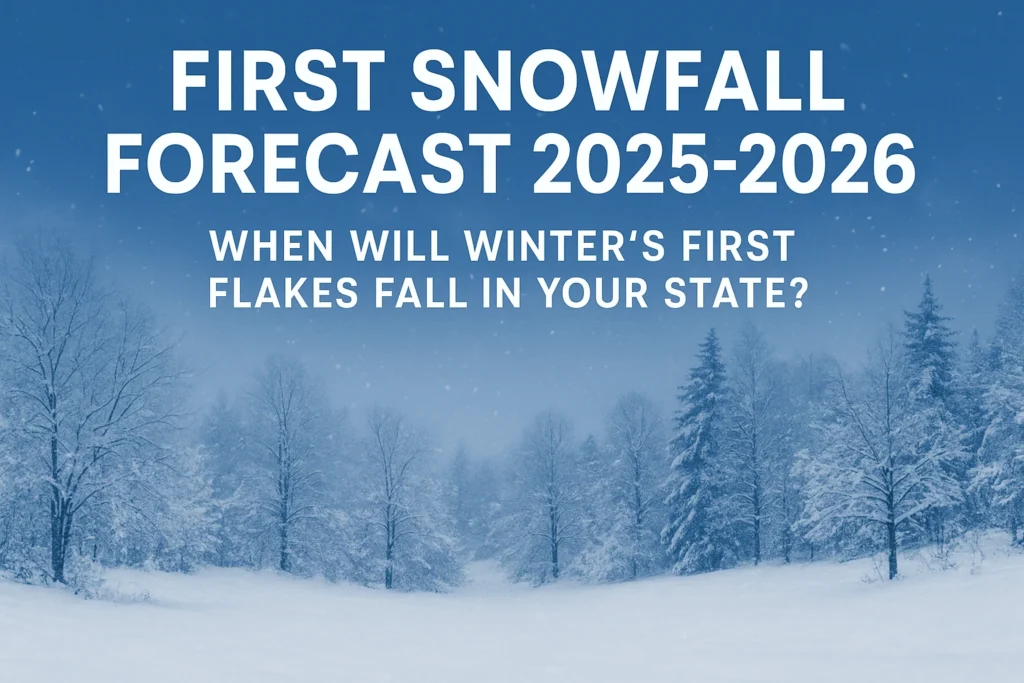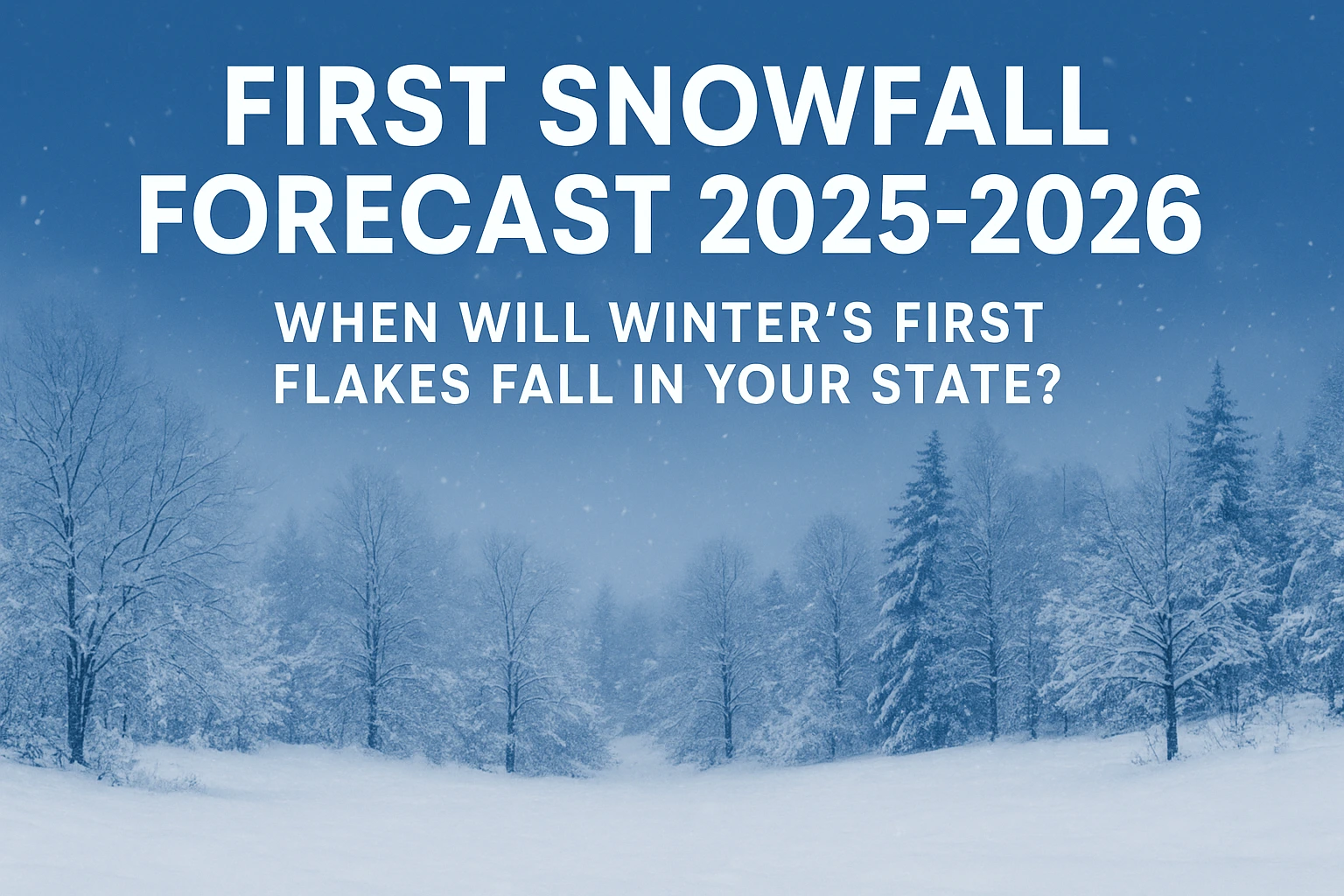First Snowfall Forecast 2025-2026: Every year, the hush of early winter is broken by a magical moment: those first soft flakes swirling in the air, landing on rooftops, trees, and open fields. That first snowfall isn’t just poetic for travelers, local authorities, farmers, and winter sports enthusiasts alike, it’s a signal to shift into full winter mode. In this post, we explore how meteorologists predict that first snow, what 2025-26 appears to have in store, and how the timing might vary from one region or state to another.
First Snowfall Forecast 2025-2026-Overview
| Article on | First Snowfall Forecast 2025-2026: When Will Winter’s First Flakes Fall in Your State? |
| First Snow Timing | Northern/mountain: Sept–Oct, Southern: Dec–Jan |
| Reason for Variation | Temperature, storms, jet stream, ocean patterns |
| Travel Impact | Early snow can disrupt roads and flights |
| Snow in Warm States | Rare, mostly in high-altitude areas |
| Preparation Tips | Check forecasts, stock supplies, ready heating |
Why Forecasting First Snowfall Matters
Forecasting the first measurable snowfall isn’t about guessing when a light dusting might occur; rather, it’s an attempt to identify when meaningful accumulations (that affect travel, infrastructure, and safety) may begin. This matters for several reasons:
- Infrastructure and public safety: Municipalities need time to stock salt, grit, snowplows, and rescue equipment.
- Transportation & travel planning: Airlines, highways, and rail systems benefit from knowing likely windows of early disruption.
- Agriculture and ecology: Early snow or frost can damage vulnerable crops or affect soil moisture dynamics.
- Tourism & recreation: Ski resorts and winter-lodge businesses can set opening dates and staffing more reliably.
- Public preparedness: Households can ready heating systems, power backup, and emergency supplies.

How Meteorologists Make the Prediction
Forecasting the first snow is not just about “cold air arriving” — it’s about the interplay of multiple atmospheric and oceanic factors. Here’s how experts typically approach it:
1. Historical Analogs & Long-Term Records
Meteorologists examine decades of snowfall records in a region to identify patterns: which years had early snow, which didn’t, and what atmospheric setups corresponded. This helps identify analog years that may mirror 2025-26 conditions.
2. Oceanic and Atmospheric Oscillations
Features such as the El Niño / La Niña cycles, Pacific Decadal Oscillation (PDO), or the North Atlantic Oscillation (NAO) influence large-scale weather patterns. For example, a strong La Niña can push cold air southward earlier.
3. Jet Stream Position & Strength
Where the polar jet resides, how wavy it becomes, and how strongly it dips into midlatitudes drastically affect cold-air incursions and snowstorm potential.
4. Sea Surface Temperatures & Polar Vortex Behavior
Warm or cool sea surfaces can modulate moisture availability and temperature gradients. Meanwhile, disruptions in the polar vortex can eject cold air masses earlier or later.
5. Model Output & Ensemble Forecasts
Modern numerical weather prediction (NWP) models run multiple simulations (ensembles) to account for uncertainty. By comparing model runs and weighting recent observations, forecasters estimate likely windows of first accumulation.
What the 2025-26 Forecast Suggests
While each country or state will have its own nuance, here’s a generalized projection for regions across temperate to mountainous zones, based on current model trends and analog years:
| Region / Zone | Estimated Window for First Measurable Snow | Typical Snowfall Range* | Notes / Risks |
| High Mountain Ranges (alpine / Rockies / Himalaya) | Late September – Early October | Heavy — cumulative | Altitudes will see snow earliest; passes often close quickly |
| Northern Mid-Latitude Plains | Mid to Late October | Moderate to heavy | First snow may be intermittent before settling |
| Midwest / Great Lakes / Interior Cold Zones | Late October – Early November | Significant (especially lake-effect) | Snowstorms may deliver rapid accumulation |
| Northeastern / Atlantic Coast Regions | Early to Mid November | Moderate to heavy | Coastal storms can bring early surprises |
| Central Plains / Temperate Interiors | Mid November – Early December | Light to moderate | Frosts can precede snow |
| Southern High Altitude / Mountains | December – Early January | Light | Snow in low elevations is rare early on, more common in high topography |
State-by-State or Local Forecast Considerations
To make this more concrete, here’s a breakdown of what residents in specific types of states might expect:
Mountain States / High-Elevation Regions
These areas are almost always first to see measurable snow each season, simply by virtue of altitude. Expect passes and ridges to see snow in late September or early October. Lower valleys may follow a few weeks later, depending on cold air pooling and moisture.
Northern Plains & Interior States
In states far from coastlines, the first snow often arrives in October. Some years, you might see isolated flurries earlier, but meaningful accumulation typically occurs in mid to late October. The key is when successive storms begin to push enough moisture eastward.
States in the Great Lakes / Inland Northeast
Because of lake-effect snow and coastal storms, these states face more variability. A cold early blast can lay down accumulation in late October, but snow often becomes persistent in November. Coastal storms (nor’easters, blizzards) can also deliver the first big dumps.
Central / Temperate States
These are transitional zones. First snow in many of these states might come in November or even early December. Often, the initial snowfall might not linger — it may melt — before winter fully arrives.
Southern States with High Terrain
In warmer latitudes, snow is rare and typically confined to mountain zones. When snow does fall, it’s often in December or January, and often light unless a cold air outbreak combines with moisture.
What Factors Could Delay or Accelerate Snow
Forecasts are educated estimates, and several dynamic factors can shift the timing:
- Warm Intrusions: Sudden southerly airflows or warm storms can delay the onset of measurable snow by melting early flakes.
- Moisture Deficits: Even if cold air is present, if moist air masses fail to arrive, snow may not occur.
- Changing Jet Stream Patterns: A stronger-than-expected ridge or an unexpected shift in the jet can push the cold air away.
- Climate Change & Variability: Warming trends affect snow longevity, temperature thresholds for accumulation, and storm frequency.
- Local Topography & Microclimate: Valleys, elevation, wind sheltering, or urban heat islands can delay accumulation or weaken snow cover.
Final Thoughts
The 2025–2026 winter season is shaping up to bring an early start for many northern and mountain regions, while southern areas may see snow later than usual. Though forecasts can shift, one thing remains certain: winter’s first snow always brings a sense of calm and renewal. Stay prepared, keep an eye on local updates, and enjoy the beauty and magic of the season’s first flakes.
FAQs for First Snowfall Forecast 2025-2026
When will the first snow arrive?
Northern/mountain areas: Sept–Oct; Southern areas: Dec–Jan.
Why does it vary yearly?
Due to temperature, storms, jet streams, and ocean patterns.
Will it affect travel?
Yes, early snow can disrupt roads and flights.
Can warm states see snow?
Rarely, mostly in high-altitude regions.
How to prepare?
Check forecasts, stock supplies, and ready heating systems.






